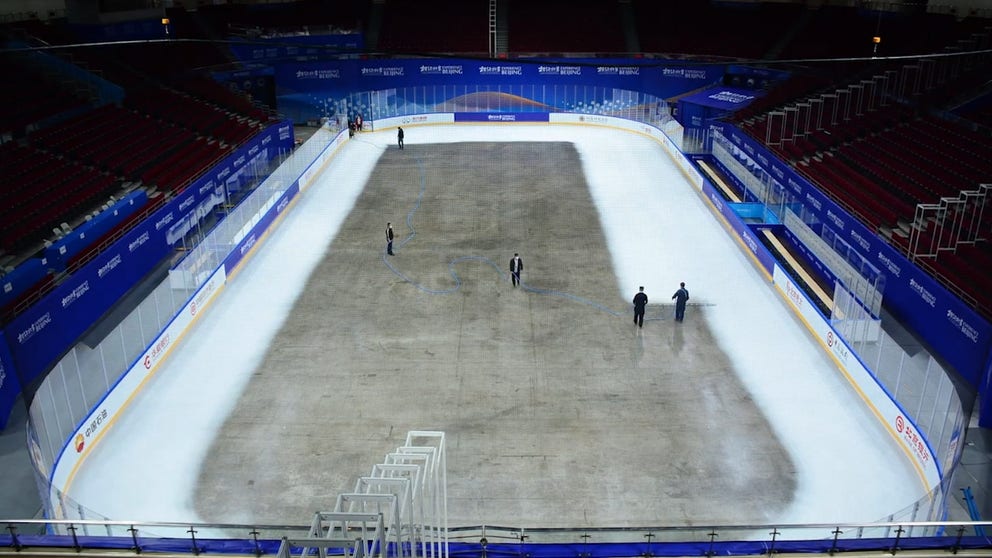How skating rink ice is built to be a perfect 10
Whether in small arenas, at NHL games or at the Olympics, many ice rinks around the world are built to a certain standard to ensure athletes’ safety.
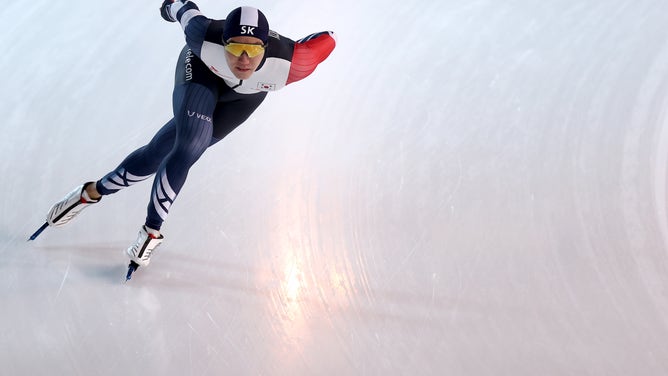
Speed skater on the ice.
(Dean Mouhtaropoulos / International Skating Union / Getty Images)
The ice skating rink is a stage for everything from pleasant pastimes to world championships.
But unbeknownst to many who’ve skated across a pristine, white ice rink, the process of building the ice on which they glide is a feat in itself.
By combining art and science, ice makers build ice with the care and attention worthy of champions.
Behind the curtain
How Ice Rinks Are Made
Whether in small arenas or at the Olympics, many ice rinks around the world are built to a certain standard to ensure athletes’ safety.
"There's a lot of things that go behind behind the scenes in almost every sport — from turf management to things like ice rinks," said John Monteleone, the director of education for the United States Ice Rink Association.
The U.S. Ice Rink Association is a non-profit serving the ice rink industry and a joint venture between U.S. Figure Skating and U.S.A. Hockey.
According to Monteleone, the quality of ice in skating rinks is largely similar across the board; however, ice conditions are a bit more controlled when professional sports are involved.
"When you look at the level of athletes that are competing on this ice, you run into athlete safety," he said.

NHL players compete at the 2012 Tim Hortons All-Star Game
(Jet Ice)
According to Monteleone, ice surfaces that aren’t built correctly may lead to cracking, stress fractures and large holes in the ice.
"You'd hate to see an athlete end their career and their dreams because they skated through something that broke an ankle or tore up a knee," he said.
"It's important to have certain standards and certain procedures that everyone follows so that you can hopefully assure the right result."
That result comes with a lot of time, care and attention.
"It's not just freezing water," Monteleone said. "There is a science behind it."
Step-by-step, layer-by-layer

Curling athletes at the 2021 Le Gruyère AOP European Curling Championships in Norway.
(Jet Ice)
According to Monteleone, building skating rink ice for high-end athletes can take four to five days.
"Putting ice in is not a simple process — it's extremely labor-intensive, and it's basically following a step-by-step method," said David Loverock, the vice president of Jet Ice Limited.
Jet Ice is a Canadian ice making company that works with organizations, such as the International Olympic Committee, the National Hockey League and U.S. Figure Skating, to build skating rink ice.
LEARN: From bones to blades: the evolution of ice skating
According to Loverock, one of the first steps to building ice begins with the foundation of many skating arenas: a clean, gray slab of concrete.
"They pull that slab down to 18 degrees, 16 degrees," he said. "So, the concrete is now set below the freezing point."
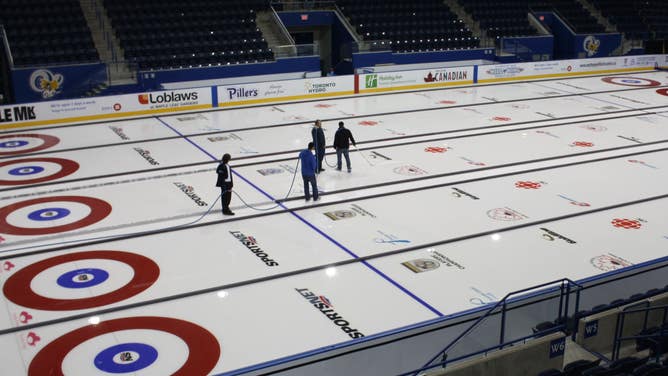
Ice makers prepare the ice for a curling competition in Toronto.
(Jet Ice)
This cooling process is similar to that used in refrigerators. According to Monteleone, a series of tubes run through the cement, carrying refrigerants that help remove heat from the skating rink floor.
"And then from there it's just a matter of layering on thin layers of water to make the ice attach to the concrete," Loverock said.
"Taking it from the cement slab to the actual skating surface, there's at least 125 different layers of water that are applied," Monteleone said. Each layer is applied as a mist, which freezes immediately as it hits the surface.
He added, "You'll see a build take four or five days in order to build it as much of a dense surface as you can, as opposed to just turn it on a fire hose and put a bunch of water down and hoping for the best."
Priming the canvas
According to Monteleone, building ice can involve roughly 14,000 to 15,000 gallons of water.
But after the first 500 to 1,000 gallons, an aesthetic and practical step is taken: the ice is painted white.
"A cement floor is going to be gray," Monteleone said. "So when you turn on your competition lighting and it hits that surface and get sucked up."
"If you have a white surface, it reflects more. It's brighter, more energy there."
According to Loverock, one of the early adopters of painting ice white was the NHL. They started the practice around the 1950s as a way to help make lines and other elements on the ice pop.
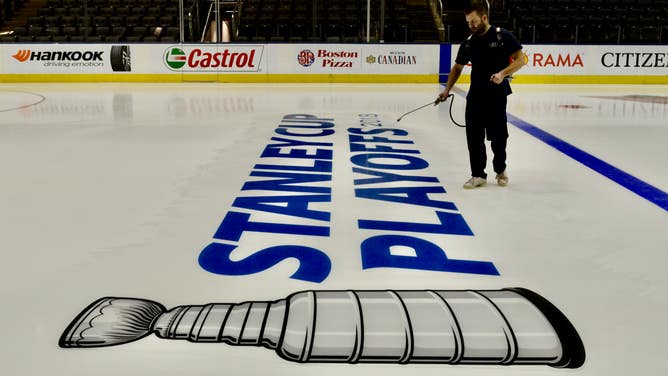
Ice maker preparing the ice rink for the NHL 2018 Stanley Cup playoffs. Logos and hockey pucks stand out on the white ice surface.
(Jet Ice)
"You've got a three-inch puck and it's black, and you're throwing it around an ice sheet. You want that definition of where is the puck," Loverock said.
Painting skating rink ice white gained in popularity over the following decades, becoming a standard for virtually all ice skating rinks.
Today, logos and other designs are placed on the ice, with a layer of white ice serving as a bright canvas.
The role of weather

Outdoor heat and humidity can affect the ice built in indoor skating rinks.
(Moritz Frankenberg / picture alliance / Getty Images)
Building ice relies on a number of factors, such as paint quality, water quality and the right temperature in the venue.
However, conditions outside a venue can also play a role.
"You're typically recycling your indoor air and exchanging that with outdoor air," Monteleone said.
For example, rainy weather conditions can introduce humid air into the rink, which can cause condensation that drips onto the ice surface.
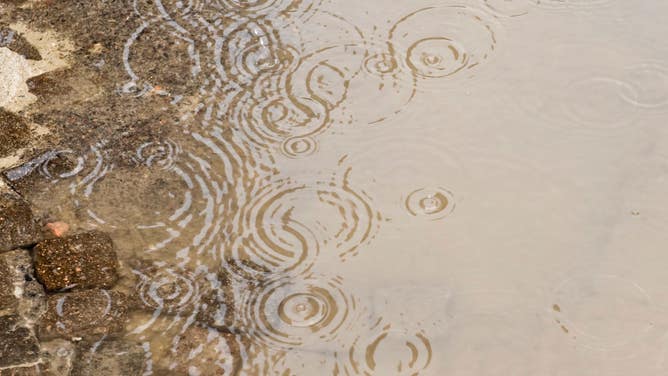
Rain drops create rings of ripples in a puddle. Moist, humid air from rainy weather conditions can compromise the integrity of indoor skating rink ice.
(Giovanni Mereghetti / Education Images / Universal Images Group / Getty Images)
Also, warm outdoor air can make building and cooling ice challenging.
"Our last trip to Las Vegas, we made ice at night because it was only 80 degrees outside instead of 120 degrees," he said.
Warm weather conditions can also affect the temperature of the water used to build ice.
"You typically like your tap water for painting to be between 45 to 60 degrees, and it comes out of the tap at 90 degrees. So, you're buying a lot of ice in order to bring that water down so that it can apply and do what it's supposed to do," he said.
The perfect landscape
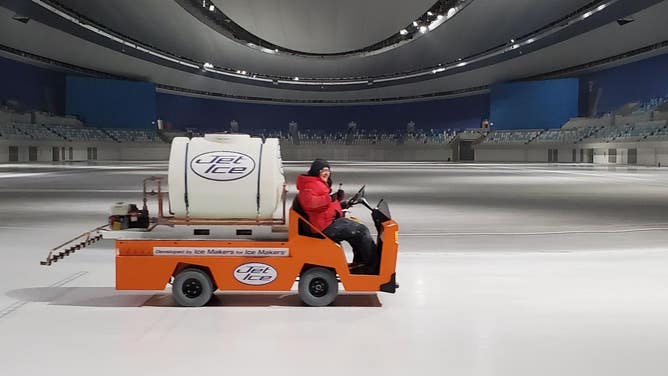
Ice maker builds the ice at the National Speed Skating Oval at the Beijing Olympics 2022.
(Jet Ice)
A lot of care and attention go into the making of skating rink ice.
"I sometimes think the ice maker is the most unappreciated guy in the arena sometimes," Loverock said.
"He's the guy that's thinking ahead. He's the guy that goes out and does the right amount of cut, he's the guy that puts down the right amount of water," he said.
"He's the guy that goes out and looks at the sheet of ice he's going to do the work on, and he comes off the ice — and hopefully, he's left him a perfect landscape."
